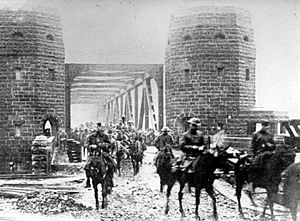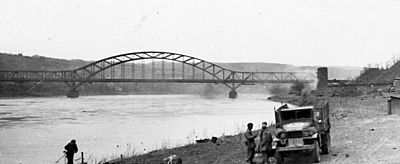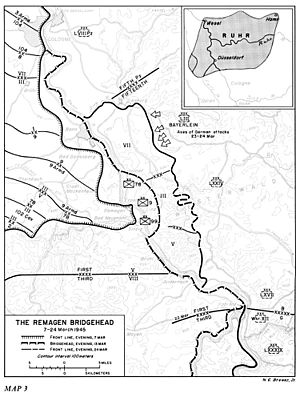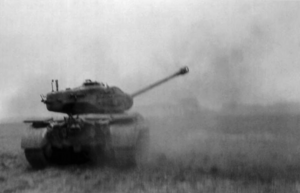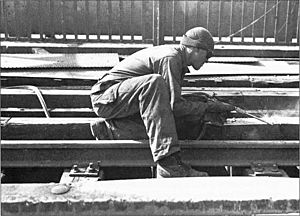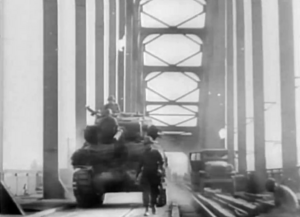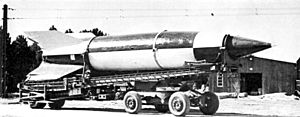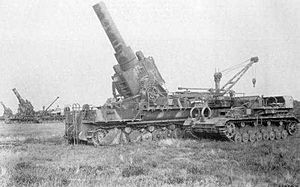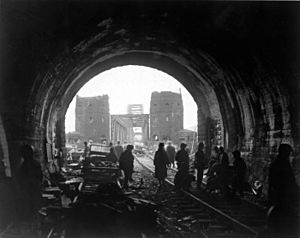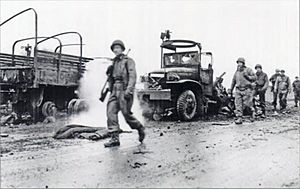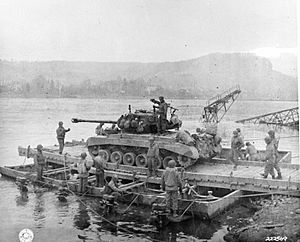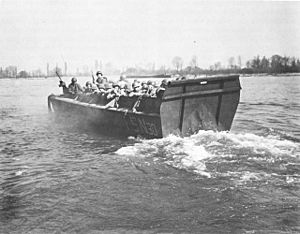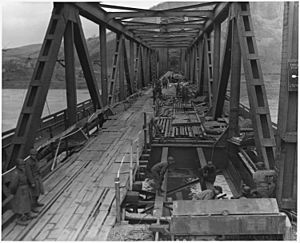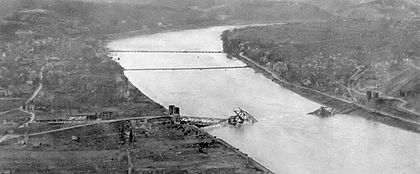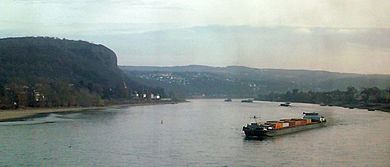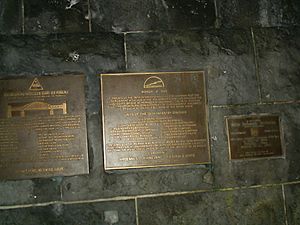Battle of Remagen facts for kids
Quick facts for kids Battle of Remagen |
|||||||
|---|---|---|---|---|---|---|---|
| Part of Operation Lumberjack during the Western Allied invasion of Germany in the Western Front of the European theatre of World War II | |||||||
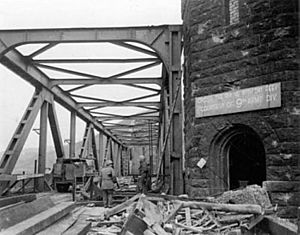 American forces cross the Ludendorff Bridge at Remagen on 8 March 1945 |
|||||||
|
|||||||
| Belligerents | |||||||
| Commanders and leaders | |||||||
| Strength | |||||||
| 1st Army | 7th Army Volkssturm |
||||||
| Casualties and losses | |||||||
| At least 990 casualties, 30+ tanks |
Unknown | ||||||
The Battle of Remagen was an important battle during World War II. It happened from March 7 to March 25, 1945. American soldiers unexpectedly captured the Ludendorff Bridge over the Rhine River in Germany. This bridge was still standing, even though the Germans tried to blow it up.
The Americans quickly secured the bridge. They also built more temporary bridges nearby. Having a bridge across the Rhine helped the Allies move into Germany much faster. It sped up their plans by about three weeks. This action also stopped the Germans from getting their forces ready on the other side of the river.
After capturing the Siegfried Line, the 9th Armored Division moved very fast. They were surprised to find the bridge still standing. The Germans had placed about 2,800 kg (6,170 pounds) of explosives on it. But when they tried to blow it up, only some of the explosives went off.
The battle for the Ludendorff Bridge involved new weapons and tactics. For 10 days, the Germans tried everything to destroy the bridge. They used soldiers, tanks, cannons, mortars, and even floating mines. They also attacked with new Arado Ar 234B-2 jet bombers.
To protect the bridge, the Americans gathered many anti-aircraft guns. This created one of the biggest anti-aircraft battles in American history. The Americans saw 367 German planes attack the bridge. They claimed to have shot down almost 30% of them. The German air attacks failed.
On March 14, Adolf Hitler ordered V2 rockets to be fired at the bridge. This was the first time these missiles were used against a specific target. It was also the only time they were fired at a German target. The 11 missiles launched killed some Americans and Germans. But none landed closer than 500 meters (about a third of a mile) from the bridge.
The Germans also sent seven navy demolition swimmers. These "frogmen" wore special underwater gear. But the Americans used top-secret Canal Defence Lights. These powerful searchlights found the frogmen in the dark. All of them were either killed or captured.
Capturing the bridge was big news in America. It allowed Allied commander Dwight D. Eisenhower to change his war plans. The Allies quickly moved five divisions across the Rhine into the Ruhr, Germany's industrial heart.
The bridge had survived many bombings and attacks. But it finally collapsed at 3:00 pm on March 17. This killed 33 American engineers and wounded 63. However, by then, U.S. Army engineers had built other bridges. More than 125,000 troops had crossed the Rhine. The Americans broke out of the bridgehead on March 25, 18 days after the bridge was first captured. Many believed capturing the bridge helped shorten the war. The Ludendorff Bridge was not rebuilt after World War II.
Contents
The Bridge and Its Location
The Ludendorff Bridge connected the village of Erpel on the east side with Remagen on the west. It was named after German General Erich Ludendorff. The bridge carried two train tracks and walkways for people. It was about 400 meters (1,300 feet) long. The main steel part was 325 meters (1,066 feet) long.
The bridge was built for military use. It had strong stone towers on both sides of the river. These towers had openings for fighting and could house soldiers. On the eastern side, a 396-meter (1,299-foot) tunnel went through a steep hill called Erpeler Ley.
German Plans for Demolition
The bridge was designed with spaces for explosives. But when the French occupied the area after World War I, they filled these spaces with concrete. In 1938, the Germans attached 60 metal boxes to the bridge girders. Each box could hold 3.66 kg (8 pounds) of explosives.
By March 7, 1945, these charges had been removed and stored nearby. The Germans placed other charges on the two main piers. They put 2,000 kg (4,400 pounds) of explosives in the west pier. On the east pier, they attached two 300 kg (660 pound) charges. All these charges were connected to an electric fuse. There was also a backup fuse that could be lit by hand.
Allied Advance to the Rhine
In late 1944, the Allies tried many times to bomb the bridge. They wanted to stop German supplies from crossing. On October 9, 1944, bombers damaged the bridge, but it was quickly repaired. More bombing raids in December, January, and February also failed to destroy it.
Operation Lumberjack was a plan to get ready for a much larger operation called Operation Plunder. This big plan involved over a million troops. Field Marshal Bernard Montgomery planned to cross the Rhine in late March.
After pushing back the Germans in the Battle of the Bulge, the Allies moved quickly into western Germany. General Eisenhower wanted to stop German forces from escaping across the Rhine. He also wanted to find a good place for the Allies to cross. The Allies didn't expect to capture a bridge intact. But Eisenhower gave an order: if any unit found a bridge standing, they should use it fully.
On March 1, 1945, only four of the 47 bridges across the Rhine were still standing. The Germans destroyed three of them in early March. The Ludendorff Bridge at Remagen was the last one.
German Defenses Were Weak
German commanders thought the Allies would cross the Rhine in a different area. They didn't expect an attack at Remagen. The German forces defending the bridge were very weak. On March 5, the bridge was defended by only 36 men, many of whom were recovering from injuries. There were also a few engineers and anti-aircraft gun crews.
The German commander for the bridge, Captain Willi Bratge, asked for more soldiers and explosives. But his requests were denied. On March 6, the American 9th Armored Division was only 14 km (9 miles) from the Rhine. The speed of their advance surprised the Germans.
Hitler had ordered that the Siegfried Line be held at all costs. This made German commanders afraid to retreat. They often gave orders that couldn't be followed. This confusion meant German forces paid less attention to the bridges.
On March 6, the German general in charge of the Remagen area was captured. The new commander, General Otto Hitzfeld, learned he was responsible for the bridge at 1:00 am on March 7. He sent his adjutant, Major Hans Scheller, to take command. But Scheller arrived only two hours before the Americans.
Captain Bratge had only 36 sick soldiers. The bridge was also defended by 125 engineers, 180 Hitler Youth, 200 Luftwaffe anti-aircraft men, and about 500 civilian Volkssturm. Most of these troops were poorly trained and equipped. Many German soldiers crossing the bridge just wanted to escape.
Americans Find the Bridge
On the afternoon of March 7, 1945, Lt. Col. Leonard Engemann led his task force towards Remagen. Their goal was to capture the town. They didn't have specific orders about the Ludendorff Bridge.
At 12:56 pm, scouts from the 89th Reconnaissance Squadron reached a hill overlooking Remagen. They were amazed to see the Ludendorff Bridge still standing. Lt. Karl H. Timmermann and another officer radioed the surprising news. Engemann saw German vehicles and soldiers rushing across the bridge. Civilians and even animals were also using it.
Captain Bratge was in Remagen, directing traffic onto the bridge. Timmermann asked for artillery to fire on the bridge to slow the Germans. But the artillery commander refused, fearing American troops might be hit.
Battle for the Bridge
When Major Ben Cothran saw the bridge, he radioed Brig. General William M. Hoge. Hoge quickly arrived and ordered Engemann to capture the bridge immediately. Timmermann, who had just been promoted, was ordered to lead his infantry company into Remagen. They were supported by tanks.
Hoge didn't know how many German forces were on the other side. The bridge could be a trap. But the chance to cross the Rhine was too important to miss.
At 1:50 pm, American troops moved towards Remagen. Thirty minutes later, 17 tanks followed. They advanced quickly through the town against weak German resistance. The Germans relied on local citizens, called Volkssturm, for defense. There were no strong defenses like anti-tank ditches or mines. The Americans quickly reached the western end of the bridge. Their tanks began firing on the bridge and the east shore.
Around 3:00 pm, U.S. soldiers learned from a captured German that the bridge was set to be destroyed at 4:00 pm. Timmermann called for artillery to create a smoke screen over Erpel.
Germans Try to Blow Up the Bridge
German forces on the west bank rushed across the bridge as the Americans approached. Captain Bratge wanted to blow up the bridge early. But he needed written permission from Major Hans Scheller. Hitler had ordered that bridges should only be blown up at the very last moment, with written orders. This made officers nervous.
Major Scheller saw how poorly defended the bridge was. He tried to get passing German troops to help, but they just drove across. Scheller decided the bridge couldn't be defended. He was ready to destroy it. But Lieutenant Karl Peters asked for more time to get his unit across. Peters had new, secret rocket launchers he didn't want the Americans to capture. Scheller agreed to wait.
Captain Karl Friesenhahn was in charge of the demolition charges. He had asked for 600 kg (1,320 pounds) of military explosives. But on March 7, he received only 300 kg (660 pounds) of weaker, industrial explosives. He placed all of it on the southeastern pier. At 2:00 pm, as Americans got close, he blew up a charge under the stone archway leading to the bridge. This created a 9.1-meter (30-foot) crater.
Scheller and Bratge went into the railroad tunnel where the detonator switch was. Friesenhahn followed, but an exploding shell knocked him out. When he recovered, Bratge yelled at him to blow up the bridge. Friesenhahn insisted on a written order from Scheller. Bratge ran to get it. When he returned, Friesenhahn still wanted the order in writing.
U.S. Forces Cross the Bridge
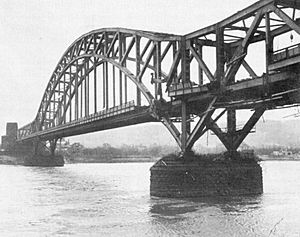
German machine gunners in the bridge towers fired at the Americans. At 3:20 pm, Friesenhahn connected the detonator and twisted the handle. Nothing happened. He tried again. Only American shells hitting nearby could be heard. Both Friesenhahn and Bratge knew the severe consequences if they failed to destroy the bridge.
Friesenhahn thought the electrical circuit was broken. Corporal Anton Faust volunteered to run out of the tunnel and manually light the backup fuse on the eastern pier. He ran 90 yards (82 meters) through gunfire and smoke. He lit the fuse and ran back.
At 3:50 pm, 10 minutes before the Germans were expected to blow the bridge, American tanks fired. They drove the German defenders from the bridge and its piers. The tanks also attacked German anti-aircraft guns on the east bank.
Lt. Timmermann led his squad onto the west side of the bridge. Just as they approached, Corporal Faust set off the secondary explosives. Both Germans and Americans watched the smoke clear. They were shocked to see the bridge still standing. Only the charge on the southeast pier exploded. But the weak industrial explosive failed to destroy the strong steel bridge.
The explosion made large holes in the bridge deck and twisted some steel beams. It also created a 9.1-meter (30-foot) gap in the southern side of the bridge. Timmermann saw Germans running around and thought they were preparing another blast. American soldiers took control of the two bridge towers on the west bank. They captured German machine gun crews and used the towers to provide covering fire.
Timmermann ordered half his men to the south side to deal with German machine gun fire. He told the other half to remove demolition charges from the western half of the bridge. Lt. Hugh Mott and two sergeants climbed under the bridge. They began cutting wires to the remaining charges.
The railroad tracks on the bridge were covered with wood planks for vehicles. American infantry came under fire from German snipers and machine guns. A Sherman tank destroyed the sniper boat. Tanks fired on the other side of the river. This helped the infantry cross the bridge.
American Capture of the Bridge
U.S. troops dodged German fire, cutting demolition wires and throwing explosives into the river. They didn't know if the Germans would detonate the rest of the charges.
Sergeant Alexander A. Drabik ran the entire 117-meter (384-foot) bridge. His squad secured the eastern side. Drabik was the first American soldier to cross this bridge. He was the first enemy soldier since the Napoleonic Wars to cross the Rhine and capture German land. Drabik and his squad crossed without injury.
Lt. Timmermann, who was born in Germany, was the first American officer to cross. Sergeant Dorland reached the far shore and destroyed the main demolition switch box. Sergeant DeLisio captured a German machine gun team. The rest of the American infantry followed.
Lt. Mott and his sergeants found about 160 kg (350 pounds) of unexploded charges. They found that a steel pipe with wires to the main charge had been cut. Engineers also found a 230 kg (500 pound) TNT charge that didn't explode because its blasting cap failed. Americans later found another 1,400 pounds (635 kg) of explosives inside the piers.
Eisenhower's Decision
Major General John Millikin had ordered the 9th Armored Division south. But General Hoge decided to disobey orders and send forces across the bridge. He called Major General John W. Leonard to tell him the bridge was captured. If his gamble failed, Hoge risked a court-martial.
The news reached General Omar Bradley and then General Eisenhower. Eisenhower was having dinner when he heard. He told his guests, "He's got a bridge across the Rhine. And he apologized for it, said it was badly located at Remagen." Eisenhower told Bradley to send divisions that were supposed to seize Cologne across the Remagen bridge instead. He then told Field Marshal Montgomery, whose big Operation Plunder was planned for later.
Official orders were given to Hoge to secure the bridge. Engineers began repairing the bridge in the dark. By midnight on March 7, only about 120 American troops secured the east bank. If the Germans had counterattacked strongly, they might have pushed the Americans back.
The capture of the bridge was front-page news in American newspapers. War correspondent Andy Rooney was the first reporter there. He called it "a reporter's dream." A sign was put up at the bridge entrance: "Cross the Rhine with dry feet-courtesy of the 9th Arm'd Div."
Bridgehead Established
After the bridge was captured, U.S. Army engineers immediately began repairs. On March 8, the 1st Battalion/310th Infantry Regiment crossed the bridge. Over the next two days, the 78th, 79th, and 99th Infantry Divisions followed.
The roads leading to Remagen quickly became jammed with hundreds of trucks, tanks, and troops. The approaches to the bridge were often backed up for miles. First Lieutenant Jack Hyde of the 9th Military Police Company managed the traffic. He set up strict rules to keep things moving. Hyde was later awarded the Silver Star for his bravery.
Allies Gain Eastern Shore
Engineers weren't sure the bridge could hold tanks. But they needed to reinforce the east side. At 12:15 am on March 8, nine Sherman tanks from Company A, 14th Tank Battalion, carefully crossed. They moved into positions to secure the bridgehead.
An M10 Tank Destroyer fell into a hole on the bridge. Engineers worked all night to get it out. While the bridge was blocked, other troops crossed on foot. The east side of the bridge and Erpel were secured overnight by the tanks and troops. The American hold on the east bank was still weak. The Germans still controlled the hills overlooking the bridge. If the Germans had launched a strong counterattack in the first 48 hours, they might have succeeded.
By the evening of March 8, over 8,000 soldiers had crossed the bridge. The U.S. bridgehead was 1 mile (1.6 km) deep and 2 miles (3.2 km) wide. On the morning of March 9, the first ferry began crossing the Rhine.
Anti-Aircraft Defense
After capturing the bridge, the U.S. Army lined up many anti-aircraft guns to protect it. By March 9, five U.S. anti-aircraft battalions were watching for planes. They had many machine guns and radar systems ready.
Colonel Patterson, in charge of anti-aircraft artillery, called it the "million dollar show." He said, "Don't worry about identification. If anything approaches Remagen Bridge, shoot it down."
U.S. Army Air Forces fighter planes also protected the bridge. They attacked German vehicles, tanks, and trains heading towards the bridgehead. On March 14, they destroyed 21 German planes. On March 15, they destroyed 256 motor transports.
German Counterattack
When the Ludendorff Bridge was captured, the Germans were completely surprised. Major Scheller tried to contact his superiors, but his radios and phones didn't work. He rode a bicycle to report in person. The Germans in the immediate area had to counterattack with whatever forces they could find. There were no reserves ready.
German Leadership Unaware
For most of the first day, Field Marshal Walter Model didn't know the bridge had been captured. He was busy trying to save German forces trapped on the west bank. On the night of March 7, Model finally learned the Allies had crossed. He put General Joachim von Kortzfleisch in charge. Kortzfleisch gathered about a hundred Luftwaffe, Hitler Youth, Volkssturm, and police units. They attacked through the night, trying to blow up the bridge, but failed.
Conflicting Orders and Delays
On the morning of March 8, Major Herbert Strobel received conflicting orders. One general told him to continue rescuing German troops. Another told him to gather every man and counterattack. Strobel chose to attack. He assembled about 100 engineers, but they were captured when they reached the bridge.
The Germans were determined to destroy the bridge. On March 9, General Fritz Bayerlein was put in charge. He had led the Panzer Lehr Division during the Battle of the Bulge. Model gave Bayerlein 24 hours to plan. Bayerlein was given the 11th Panzer Division (4,000 men, 25 tanks, 18 artillery pieces) and the 9th Panzer Division (600 men, 15 tanks, 12 artillery units). He also got the 106th Feldherrenhalle Panzer Brigade and a regiment of the Panzer Lehr Division.
But the 11th Panzer was 100 km (62 miles) north. Lack of fuel and American air attacks made moving forces difficult. Bayerlein wanted to wait for all units to arrive. But Model ordered him to attack immediately. On March 9, German attacks were too weak. When the 11th Panzer arrived, their tanks often broke down.
Aircraft Attack the Bridge
On March 8, Alfred Jodl told Hitler the Allies had captured the bridge. Hitler was furious. He ordered the bridge destroyed at all costs. Over the next ten days, the German High Command used almost every weapon they had.
Göring formed a special unit with about 40 Arado Ar 234 B-2 jet bombers. These were escorted by 30 Messerschmitt Me 262A-2a jet fighter-bombers. This was the first time these jets were used to attack a specific target. The bombers were very fast, making them hard for American anti-aircraft units to track. Over six days, they flew nine missions but failed to hit the bridge. The Germans lost seven jet aircraft.
The Luftwaffe also attacked with propeller planes like Messerschmitt Bf 109s, Focke-Wulf Fw 190s, and even old Ju 87D "Stuka" dive-bombers. The Stukas could dive accurately but were slow. The American anti-aircraft fire was very intense. On March 8, eight Stukas attacked and all were shot down. Thirty minutes later, eight more attacked and were also shot down. The strong anti-aircraft fire kept the Germans from destroying the bridge.
On March 9, the Germans sent 17 planes, but their bombs missed. The Americans claimed to have shot down 13 of them. From March 7 to 17, the Americans shot down 109 planes out of 367 that attacked the bridge.
V2 Rockets Used
On March 14, Hitler ordered SS General Hans Kammler to attack the bridge with V2 ballistic missiles. The German generals were shocked. These weapons were inaccurate and would likely kill German citizens and troops. On March 17, eleven V2 rockets were fired at the bridge from 200 km (124 miles) away. This was their only use against a specific target in the war. The missiles missed the bridge, landing as far away as Cologne. One hit Remagen, killing three American soldiers and damaging buildings.
Frogmen Dispatched

The Germans tried to float explosives down the river, but they were captured. They also floated mines, but these were stopped by log and net barriers built upstream. Hitler called on special operations commander Otto Skorzeny. On March 17, Skorzeny sent a special naval demolition squad with underwater breathing gear. But before they could act, they learned the Ludendorff Bridge had collapsed. Skorzeny then ordered the seven SS frogmen to attack a pontoon bridge instead.
The water was very cold. The swimmers had to enter the river 17 km (11 miles) upstream. They were discovered by American tanks using top-secret Canal Defence Lights. These were powerful searchlights used for the first time in combat. Two frogmen died from the cold, two were killed, and three were captured.
German Artillery
German artillery caused the most damage to the bridge. The Germans had over 100 artillery pieces in the area. These included howitzers of different sizes. A German artillery observer had gotten into Remagen, making their fire more accurate. On March 8–9, they hit the bridge 24 times. On March 9, they hit an ammunition truck on the bridge, making a 4.6-meter (15-foot) hole. This closed the bridge for several hours. On March 10, they hit a gasoline truck. For the next two days, Americans used ferries for gasoline and ammunition. The shells killed troops, destroyed buildings, and made the engineers' work very dangerous.
On March 11, the Germans sent a giant 60 cm (24 inch) super-heavy mortar called the Karl-Gerät towards Remagen. This weapon weighed 124 tons (273,000 pounds) and fired a shell weighing up to 2,170 kg (4,780 pounds). It arrived on March 20. After only 14 rounds that missed all the bridges, the weapon had to be moved for repairs.
Allies Expand Bridgehead
In early 1945, Eisenhower had given Field Marshal Montgomery the job of being the first to cross the Rhine. Montgomery's Operation Plunder was set for March 23. But with the Remagen bridge captured, Eisenhower told Omar Bradley to secure the bridgehead. He limited its expansion to an area that five divisions could hold. On March 9, Bradley told General Hodges to expand the bridgehead to a maximum of 40 km (25 miles) wide and 16 km (10 miles) deep.
On the morning of March 10, a large sign was placed on the bridge: "CROSS THE RHINE WITH DRY FEET, COURTESY OF 9TH ARM'D DIV". The heavy M26 Pershing tanks were too heavy for the weakened bridge. They had to wait five days to be ferried across on March 12.
On March 15, the Belgian army's 16th Fusilier Battalion crossed the Rhine at Remagen.
"Dead Man's Corner"
On the night of March 10, the 394th Infantry Regiment was sent to relieve the 9th Infantry Division on the east bank. They were trucked into Remagen on roads jammed with vehicles. The trucks drove past burning tanks and many dead soldiers. Artillery shells hit the western shore of the Rhine every 30 seconds that night.
Soldiers had to dodge around abandoned equipment and bodies. The 180-meter (200-yard) approach ramp to the bridge was heavily shelled. It was so dangerous that soldiers called it "Dead Man's Corner." Bodies piled up quickly because medics were busy with the wounded.
The 99th Infantry Division was the first complete division to cross the Rhine. They then pushed through to the Wied River and advanced east.
Additional Bridges
The Americans needed more bridges as backups and to get more troops and tanks across. On March 8, they began building the first new bridge. Supplies were secretly diverted from other armies to Remagen.
Many boats were used to ferry troops and supplies. DUKW amphibious trucks carried ammunition and fuel. U.S. Navy LCVP landing craft ferried 32 men across in seven minutes. These vessels constantly moved across the river.
The Germans targeted the new bridges as soon as construction began. German artillery observers on the hills constantly shelled the engineers and vehicles.
The 291st Engineer Combat Battalion began building a steel treadway bridge about 0.4 km (0.25 miles) downstream. The crews were repeatedly hit by artillery. Seventeen engineers were killed or wounded in one barrage. On March 10, a direct hit killed an officer and injured 19 others. One engineer said, "While working on that bridge, we were just fugitives from the law of averages." The Luftwaffe attacked for six and a half hours that day. The engineers finished the 315-meter (1,032-foot) bridge in 32 hours on March 11. It was the first Allied bridge across the Rhine.
The 51st Engineer Combat Battalion built a heavy pontoon bridge 3.2 km (2 miles) upstream. They began construction on March 10, even though the far shore wasn't fully captured. German planes bombed and strafed them, killing three men. On March 11, the engineers completed the 295-meter (969-foot) bridge in 27 hours. It was the fastest floating bridge built under fire. It opened for traffic that night.
Once the new bridges were open, the Ludendorff Bridge was closed for repairs on March 12. By March 14, the Americans had 672 anti-aircraft weapons around the bridgehead. This was the largest concentration of anti-aircraft weapons in World War II. The anti-aircraft fire was so intense that falling shells caused 200 casualties to their own side. Of the 367 German planes that attacked, the Americans shot down 109 (almost 30%).
On March 15, engineers found the Ludendorff Bridge had sagged 6 to 12 inches (15 to 30 cm). It needed extensive work. Ferries and DUKWs continued to help. By March 23, the LCVPs had carried 13,800 troops and 406 vehicles.
Bridge Fails
After months of bombings, artillery hits, and demolition attempts, the Ludendorff Bridge finally collapsed on March 17 at about 3:00 pm. In the 10 days since its capture, over 25,000 troops and thousands of vehicles had crossed it and the two new tactical bridges.
Engineers working on the bridge heard a loud snap, then the sound of breaking metal. The center of the bridge suddenly fell into the Rhine. About 200 engineers and welders were on the bridge when it fell. Lieutenant Colonel Clayton A. Rust fell into the Rhine but was pulled out.
Twenty-eight Army Engineers were killed in the collapse, and 63 were injured. Before it collapsed, five U.S. divisions had used it and the other bridges to cross into Germany. They created a strong bridgehead almost 40 km (25 miles) long and 10 to 15 km (6 to 9 miles) deep.
Three hours after the collapse, engineers began building a floating Bailey bridge. They finished the 383-meter (1,258-foot) bridge on March 20. Another tactical bridge was built on March 22, 9 km (5.6 miles) upstream. It was 418 meters (1,370 feet) long, the longest tactical bridge built by the First Army.
Breakout
When the Americans captured the Ludendorff Bridge, the Germans were completely surprised. The bridge's capture put a sudden burden on German defenses. It also increased their confusion. They had expected a large build-up before a river crossing. The breakthrough at Remagen meant the Germans lost a chance to regroup east of the Rhine.
By the time the bridge collapsed 10 days later, over 25,000 Allied troops had crossed. The Remagen bridgehead was 8 miles (13 km) deep and 25 miles (40 km) wide. This included 11 km (7 miles) of the important Ruhr-Frankfurt autobahn. The unexpected crossing allowed Eisenhower to change his plans to end the war.
On March 19, Eisenhower ordered nine First Army divisions to prepare to join General George Patton's Third Army. Patton wanted to cross the Rhine before Montgomery. On March 22, Patton's 11th Infantry Regiment quietly crossed the Rhine at Nierstein. They used amphibious trucks and landing craft, without air or artillery support. By March 23, engineers completed a bridge. They quickly established a 6-mile (9.7 km) deep bridgehead and captured 19,000 German soldiers.
By March 24, the U.S. First Army had three corps, six infantry divisions, and three armored divisions across the Rhine. The Allied breakout ended any German hope of regaining control. By March 31, three weeks after capturing the Ludendorff Bridge, all four American armies were across the Rhine River.
Aftermath
Crossing the Rhine in a single day helped shorten the war in Europe.
Shortened War in Europe
Eisenhower called capturing the bridge "one of those rare and fleeting opportunities." He said it had "incalculable effects on determining future success." He also commented, "We were across the Rhine, on a permanent bridge; the traditional defensive barrier to the heart of Germany was pierced." General George C. Marshall said, "The bridgehead provided a serious threat to the heart of Germany."
Many sources believe the capture of the Ludendorff Bridge shortened the war by weeks or months. Journalist Hal Boyle wrote it "saved the American nation 5,000 dead and 10,000 wounded." Another author said it shortened the war by about six months. Colonel F. Russel Lyons said it saved the Allies two months and 35,000 casualties.
General Albert Kesselring called the battle the "Crime of Remagen. It broke the front along the Rhine." Hermann Göring said it "made a long defense impossible."
German Punishments
Adolf Hitler was very angry about losing the bridge. He appointed General Rudolf Hübner to hold special court-martials and execute officers who failed to destroy the bridge. On March 11, Hübner tried Captain Bratge even though Bratge was a prisoner of war. Bratge was sentenced to death, but the sentence couldn't be carried out.
Hübner then tried Major Scheller and Lieutenant Karl Heinz Peters. Scheller had arrived only two hours before the Americans attacked. Peters was just trying to move his secret anti-aircraft system. Both were found guilty and faced severe consequences, including execution.
On March 17, Hübner tried Major Herbert Strobel and Major August Kraft. Kraft had placed the charges on the bridge. Strobel had ordered Kraft to counterattack, which failed. Hübner quickly found them guilty and they faced severe consequences, including execution. A sixth officer, Captain Friesenhahn, was captured but not punished. The court found he had done everything he could to destroy the bridge.
Hitler also disciplined four other generals. Generalmajor Richard von Bothmer was punished for giving up Bonn without a fight. Hitler replaced his top commander with Field Marshal Albert Kesselring. Kesselring told his troops their failure was costly.
A consequence of these severe punishments was that German officers began blowing up all sorts of bridges, even when it didn't make sense. This often hurt the German war effort.
Awards for Bravery
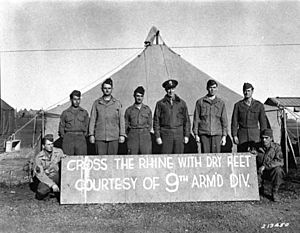
Major General John W. Leonard awarded Brig. General Hoge the Oak Leaf Cluster to his Distinguished Service Medal. On March 21, Hoge was transferred to command the Fourth Infantry Division. Leonard also awarded 13 soldiers Distinguished Service Crosses and 152 Silver Star medals.
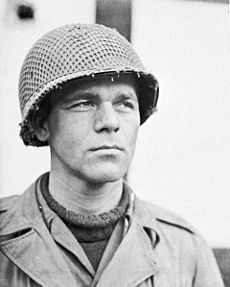
Sergeant Alexander A. Drabik, the first American enlisted man to cross the bridge, and Lieutenant (LT) Timmermann, the first American officer, both received the Distinguished Service Cross (DSC). Sergeants Joseph DeLisio, Michael Chinchar, Joseph S. Petrencsik, and Anthony Samele also received the DSC.
LT Hugh Mott and Sergeants Eugene Dorland and John A. Reynolds received the DSC for removing live demolition charges under fire.

Company A, 14th Tank Battalion, was the first tank company to cross the Rhine. They helped capture the bridge and defended against German counterattacks. Captain George P. Soumas, 1st LT C. Windsor Miller, Sergeant William J. Goodson, and 1st LT John Grimball received the DSC. The entire battalion received its second Presidential Unit Citation.
The 9th Military Police Company managed traffic and guarded the bridge. They were recognized with the Meritorious Unit Citation, the Belgian Fourragère, and the Presidential Unit Citation. 1st LT John Hyde, the Bridge Control Officer, received a Silver Star.
The 47th Infantry Regiment, the first to cross on March 8, faced strong German counterattacks. It received a Presidential Unit Citation. All units of Combat Command B of the 9th Armored Division received the Presidential Unit Citation.
The "Miracle at Remagen"
Journalists called the capture of the bridge the "Miracle of Remagen." Historian Carlo D'Este called it "one of the great sagas of the war."
When the news reached the U.S. Senate, they broke rules to clap. The House of Representatives stopped business to celebrate. The Associated Press called it "the biggest military triumph since the Normandy landings." Time magazine called it a "moment in history."
General Eisenhower said, "The whole Allied force is delighted to cheer the First Army whose speed and boldness have won the race to establish the first bridgehead over the Rhine." General Omar N. Bradley praised it as "a bold advance."
In 1954, Captain Karl Friesenhahn, the German engineer in charge of the explosives, said the American soldiers who received medals "deserved them—and then some." He added, "In my mind they were the greatest heroes in the whole war."
Later History
The bridge was not rebuilt after the war. But the standing towers were preserved. The western towers became a memorial museum. Remagen and Erpel were rebuilt, keeping their historic look.
On the 17th anniversary of the capture, veterans from both sides met. On the 40th anniversary, 130 U.S. veterans visited. On March 7, 1995, about 600 veterans and families observed the 50th anniversary. German residents thanked the U.S. service members for winning the war.
Captain Karl Friesenhahn said after the war that he had tested the electrical circuits for the explosives. He believed American artillery cut the circuit.
After the war, the Allies had many German prisoners. Over 660,000 were captured in the Ruhr Pocket. Many were held in the "Golden Mile" camp near Remagen. Conditions were very bad, with little food or water. By the time the camp closed, 1,247 prisoners had died from illness and exhaustion.
Memorials
In the cemetery at Birnbach, Germany, a memorial honors the four German officers who faced severe consequences for the bridge's capture.
In Fort Jackson, South Carolina, a stone from the bridge pier is a memorial to the 60th Infantry Regiment. An M-26 Pershing Tank is also displayed there.
Plaques remembering the battle are on the western bridge towers. They were placed by Belgian, U.S. 9th Armored, U.S. 99th, and U.S. 78th Infantry Divisions.
A piece of railroad track from the bridge is kept by the 9th Infantry Division. It is used in ceremonies to inspire engineers.
The sign that Company C, 9th Armored Infantry Battalion, placed on the bridge is displayed at the George Patton Museum in Kentucky.
Remagen Bridge Peace Museum
In 1978, Remagen Mayor Hans Peter Kürten planned a museum. When the German government decided to remove the piers, he sold pieces of them cast in resin. This raised over 100,000 German Marks.
Kürten opened the "Friedensmuseum Brücke von Remagen" (Remagen Bridge Peace Museum) on March 7, 1980, in one of the western towers. It shows the bridge's history and has a video. As of 2014, an American flag flies from one tower and a German flag from the other.
Erpeler Performance Space
In 2006, a local arts company bought the east bridge towers and the tunnel. They use it as a performance space, keeping it open to the public.
Cross on Erpeler Ley
A cross was built on top of Erpeler Ley to remember those who died in the battle.
Peace Plaque
On March 20, 2005, a plaque was placed near the bridge. It reads: "Peace Without Freedom Is Not Peace" —Konrad Adenauer. It was donated by Heinz Schwarz, who was a 16-year-old German air force helper at the bridge in 1945.


